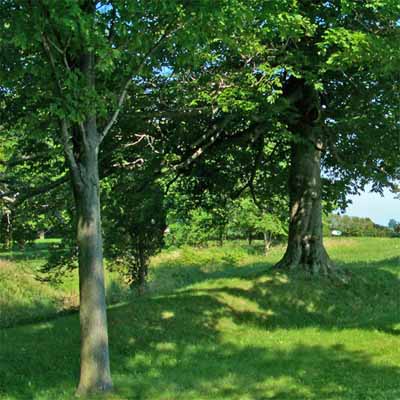Southwold Earthworks National Historic Site of Canada
Fingal, Ontario

General view
© Parks Canada Agency/Agence Parcs Canada, 2004.
Address :
7930 Iona Road, Fingal, Ontario
Recognition Statute:
Historic Sites and Monuments Act (R.S.C., 1985, c. H-4)
Designation Date:
1923-05-25
Dates:
-
1450 to 1550
(Construction)
Event, Person, Organization:
-
Attiwandaron First nations
(Builder)
Other Name(s):
-
Southwold Earthworks
(Designation Name)
Research Report Number:
1982-SUA, 2005-SDC-CDE-002
DFRP Number:
10608 00
Plaque(s)
Existing plaque: 7930 Iona Road, Fingal, Ontario
This prehistoric site was once a fortified village occupied by the Neutral Indians betwen about 1500 and 1650 A. D. An earth palisade wall, later strengthened by a second wall, protected a cluster of longhouses. The Neutrals, who emerged as a distinct group within Iroquois culture about 1450, were so-called because they did not participate in wars with traditional Iroquois rivals. This neutrality aroused the ire of the Iroquois confederacy, and Mohawk and Seneca raids brought about the demise of the Neutral nation by 1650.
*Note: This designation has been identified for review. A review can be triggered for one of the following reasons - outdated language or terminology, absence of a significant layer of history, factual errors, controversial beliefs and behaviour, or significant new knowledge.
Description of Historic Place
Southwold Earthworks National Historic Site of Canada, located near Iona, in Elgin County, is a piece of property containing the archaeological remains of a village, originally inhabited by the Attiwandaron, also known as the Neutral Iroquois. Conspicuous earthworks, a rarity in southern Ontario, surround the village and are well preserved. The interior of the village shows a typical Iroquoian pattern of closely spaced longhouses, many of which are overlapping. The overlapping houses indicate that many houses were reconstructed during the life of the village, another typical Iroquoian pattern. Official recognition refers to the archaeological site administered by Parks Canada.
Heritage Value
Southwold Earthworks was designated a national historic site of Canada in 1923. It is designated because: it is a rare and well-preserved example of an Aboriginal fortified village completely surrounded by earthworks, built by the Attiwandaron (Neutral Iroquois) between about A.D. 1450 and 1550.
Attiwandaron is a name from the Huron-Wendat language that refers to the confederacy of Iroquoian peoples living north of Lake Erie who were neutral in the conflict between the Huron-Wendat and the League of Five Nations Iroquois. The village was once home to several hundred people who lived in longhouses, which were multi-unit dwellings that housed entire extended families related by a common maternal ancestor. The village was, and is, surrounded by conspicuous earthworks. The 17th-century French referred to the Attiwandaron as the “la nation Neutre” or the Neutrals. There is no distinct descendant population of the Attiwandaron today, as the entire confederacy was dispersed or incorporated into the Five Nations Iroquois during the years 1647 to 1651. This is the only Iroquoian village administered by Parks Canada that is commemorated as a village in itself.
Source: Historic Sites and Monuments Board of Canada, Submission Report and Minutes, March 2005.
Character-Defining Elements
Key elements contributing to the heritage value of this site include: the integrity and materials of the surviving subsurface archaeological remains; features and artifacts in their original placement and extent, including the in situ vestiges, and various archaeological features both identified and as yet unidentified that relate to the occupations and activities pursued on this site; the earthworks, which form a double ring of low earthen mounds that surround the site; the flat plain of the village itself inside the earthworks, the location of the longhouses, the work spaces and common areas within the village; the views from atop the earthworks, and from the surrounding area towards the earthworks.